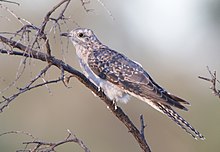Pallid cuckoo
| Pallid cuckoo | |
|---|---|
 |
|
| Scientific classification | |
| Kingdom: | Animalia |
| Phylum: | Chordata |
| Class: | Aves |
| Order: | Cuculiformes |
| Family: | Cuculidae |
| Genus: | Cacomantis |
| Species: | C. pallidus |
| Binomial name | |
|
Cacomantis pallidus (Latham, 1801) |
|
| Synonyms | |
|
Cuculus pallidus |
|
Cuculus pallidus
The pallid cuckoo (Cacomantis pallidus) is a species of cuckoo in the family Cuculidae. It is found in Australia with some migration to the islands of Timor and Papua New Guinea. It is between 28 – 33cm in size with distinctive markings such as a dark bill, a dark eye with a gold eye-ring and olive grey feet which differentiate it from other cuckoos. The pallid cuckoo is similar in appearance to the oriental cuckoo (Culculus optatus) with barred immature pallid cuckoos being often mistaken for oriental cuckoos.
Characteristics of the appearance of the pallid cuckoo include: a dark bill, a dark eye with a gold eye-ring, a shadowy dark mark from the eye down the neck, a white (or buff) mark on the nape, olive grey feet and prominent white (or buff) toothing along the tail. In flight there are conspicuous white and dark bars across the long tail. In flight it looks falcon shaped and often triggers alarm calls from passerines. The pallid cuckoo can have various morphs including light rufous morph or dark rufous morph.
In adult males the upperparts including head and neck are grey-brown and have large spots on wing-coverts. In adult females the light-rufous morph is similar to the adult male however with the dark rufous morph the hind neck patch extends onto mantle and it has barring on the chest.
A distinguishing feature of the Cuculidae family are the feet, which are zygodactyl, meaning that the two inner toes point forward and the two outer point backward.
The pallid cuckoo has been observed in various different habitats such as in woodlands, shrubland, mangroves, pastoral country, farmland, golf courses and gardens. However it prefers lightly timbered country with trees and shrubs and a sparse under-story where it can best hunt for prey.
The pallid cuckoo is widely distributed throughout mainland Australia and Tasmania. It spends the winter months in central inland Australia and the Northern Territory. The cuckoo then migrates to South East Australia’s coastal region and Tasmania, arriving generally around September or October, sometimes earlier. It has also been observed that migration occasionally occurs to the islands of Timor and Papua New Guinea in the winter months.
...
Wikipedia

